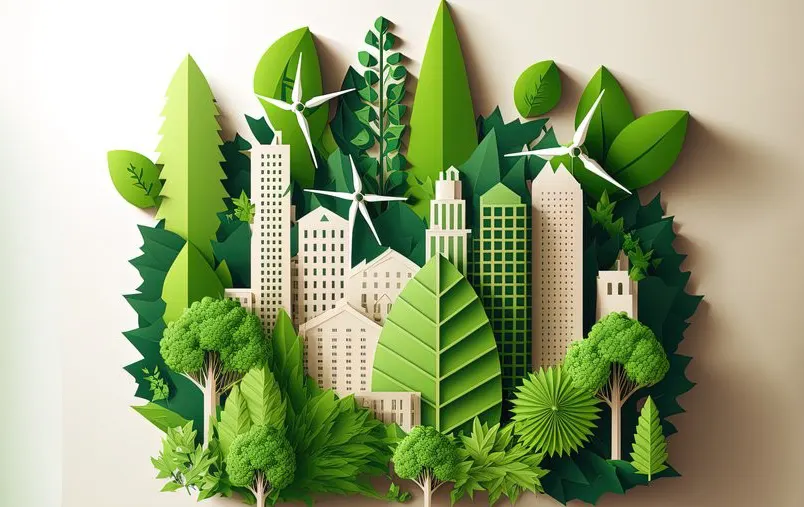
The construction and development industry in the U.S. is undergoing a significant transformation. With a growing focus on environmental responsibility and resource conservation, sustainable building practices are no longer an option but a norm. This shift is driven in part by a complex web of laws and regulations at the federal, state, and local levels.
This comprehensive guide serves as a legal book of sustainable construction and development in the U.S. in 2024. We’ll look into key regulations, explore incentive programs, and offer insights to smoothly sail across the sophisticated legal framework.
Federal Laws and Regulations
- Energy Efficiency: The National Energy Conservation Policy Act (NECPA) sets minimum energy efficiency standards for buildings. The U.S. Department of Energy (DOE) regularly updates these standards, pushing the industry towards more energy-efficient construction practices.
- Sustainable Sites: The Leadership in Energy and Environmental Design (LEED) program, a voluntary rating system developed by the U.S. Green Building Council (USGBC), is not a legal requirement, but many federal agencies incentivize LEED-certified buildings.
- Materials and Waste Management: The Resource Conservation and Recovery Act (RCRA) regulates hazardous waste disposal and encourages recycling in construction projects.
Additionally, federal procurement guidelines favor environmentally responsible materials.
State and Local Regulations
While federal regulations lay the groundwork, a significant portion of sustainable construction laws stem from state and local initiatives. Key areas include:
- Building Codes: Many states and municipalities have adopted stricter building codes that mandate energy-efficient features, water conservation measures, and the use of sustainable materials.
- Renewable Energy Requirements: A growing number of states have implemented renewable energy portfolio standards (RPS) that require a certain percentage of electricity to come from renewable sources. This can influence the design and construction of new buildings to incorporate solar panels or other renewable energy systems.
- Green Infrastructure: Local governments are increasingly promoting green infrastructure projects that manage stormwater runoff, reduce flooding, and improve air quality. These regulations may impact development plans and construction methods.
Incentives for Sustainable Construction
The U.S. government offers a variety of incentives to encourage sustainable construction practices. These include:
- Tax Credits: Federal and state tax credits are available for projects that meet specific energy efficiency or renewable energy standards.
- Grants and Loans: Programs like the Energy Star program and the Department of Agriculture’s Rural Development grants offer financial assistance for sustainable construction projects.
- Faster Permitting: Some municipalities offer expedited permitting processes for projects that achieve LEED certification or meet other sustainability benchmarks.
Staying up-to-date on the ever-evolving legal laws of sustainable construction can be a challenge. Here are some tips:
- Consult with legal counsel: An attorney with expertise in construction and environmental law can provide guidance on specific regulations and compliance requirements.
- Stay informed: Organizations like the USGBC and the American Institute of Architects (AIA) offer resources and updates on relevant laws and regulations.
- Explore government websites: Federal, state, and local government websites often provide detailed information on building codes, permitting processes, and incentive programs.
Specific Regulations
International Energy Conservation Code (IECC): Developed by the International Code Council (ICC), the IECC is a model building code that sets minimum energy efficiency requirements for residential and commercial buildings. Many states have adopted the IECC or a variation of it, making it a crucial benchmark for energy-efficient construction. ASHRAE Standard 90.1: Developed by the American Society of Heating, Refrigerating and Air-Conditioning Engineers (ASHRAE), Standard 90.1 establishes energy efficiency requirements for buildings beyond the baseline set by the IECC. This standard focuses on specific building systems like HVAC, lighting, and the building envelope.
State-Specific Examples
Sustainable construction laws vary considerably across the U.S. states. Here are some noteworthy examples:
- California: California is a national leader in sustainable construction. The California Green Building Standards Code (CALGreen) is one of the most stringent building codes in the country, mandating features like water-efficient plumbing fixtures, recycled content in building materials, and solar photovoltaic systems for certain building types.
- Texas: Texas, known for its booming construction industry, is also embracing sustainability. The Texas Holcim US Green Building Rating System encourages sustainable construction practices through tax breaks and streamlined permitting for LEED-certified projects.
Local Initiatives: Green Building Rating Systems
In the light of federal and state regulations, many localities have adopted green building rating systems that go beyond minimum code requirements. These programs often provide project certification based on a point system that evaluates performance in areas like:
- Site Sustainability: Minimizing site disturbance, preserving natural habitats, and incorporating green infrastructure.
- Water Efficiency: Utilizing low-flow fixtures, rainwater harvesting, and xeriscaping (landscaping with drought-tolerant plants).
- Energy Efficiency: Exceeding code requirements for building envelope performance, HVAC systems, and lighting design.
- Materials and Resources: Utilizing recycled content materials, minimizing construction waste, and promoting local sourcing.
- Indoor Environmental Quality: Ensuring good ventilation, natural daylighting, and control of indoor air pollutants.
Looking Ahead: Emerging Trends in Sustainable Construction Law
- Life Cycle Assessment (LCA): Regulations may increasingly consider the entire life cycle of building materials, from extraction and processing to disposal, to assess their environmental impact.
- Smart Building Technologies: Building codes may integrate requirements for smart building technologies that optimize energy use and improve building performance.
- Resilience to Climate Change: Building codes are likely to incorporate measures to make buildings more resistant to extreme weather events like floods, heat waves, and wildfires.
The Future of Sustainable Construction Laws
As environmental concerns continue to grow, we can expect to see a further tightening of sustainable construction regulations at all levels of government. This is likely to include:
- More stringent energy efficiency standards: Buildings will be required to achieve even higher levels of energy performance.
- Focus on embodied carbon: Regulations may address the carbon footprint of building materials, encouraging the use of low-carbon alternatives.
- Integration with climate change adaptation: Building codes may incorporate measures to make buildings more resilient to extreme weather events.
Sustainable construction is no longer an idea or a thought to ponder on but a legal imperative. By understanding the current legal landscape and staying informed about future trends, builders, developers, and architects can ensure their projects comply with regulations while creating a more sustainable future for the built environment.
Call to Action
Here are some resources to get you started on your sustainable construction journey
- U.S. Green Building Council (USGBC):
https://www.usgbc.org/
- Department of Energy (DOE) Building Technologies Office:
https://www.energy.gov/eere/buildings/building-technologies-office
- International Code Council (ICC) Safe Building Codes:
https://www.iccsafe.org/

